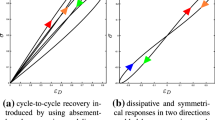Abstract
Adhesion and residual stress play a critical role in the performance and reliability of MEMS. The influence of residual stress on the adhesion-induced instability in MEMS is examined within the framework of thin elastic plate theory. The results show that the adhesion-induced instability will be mitigated if the residual stress exists in certain component of MEMS. Moreover, we find that the influence is significant only when the residual stress is under a proper magnitude (β⩽20).
Similar content being viewed by others
References
Huan Y, Zhang T H, Yang Y M. In-plane load measuring technique for the strength test of MEMS micro-cantilever. Chinese Sci Bull, 2006, 51: 2819–2823
Maboudian R, Howe R T. Critical review: Adhesion in surface micromechanical structures. J Vac Sci Tech B, 1997, 15: 1–20
Mastrangelo C H. Adhesion-related failure mechanisms in micromechanical devices. Tribol Lett, 1997, 3: 223–238
Zhao Y P, Wang L S, Yu T X. Mechanics of adhesion in MEMS-a review. J Adhes Sci Tech, 2003, 17: 519–546
Rogers J W, Mackin T J, Phinney L M. A thermomechanical model for adhesion reduction of MEMS cantilevers. J Micromech Microeng, 2002, 11: 512–520
Jones E E, Begley M R, Murphy K D. Adhesion of micro-cantilevers subjected to mechanical point loading: Modeling and experiments. J Mech Phys Solids, 2003, 51: 1601–1622
Lin M J, Chen R S. Adhesion criterion for center-anchored circular plates in microstructures. Sensors Actuat A-Phys, 2002, 101: 14–23
Yang F Q. Adhesive contact of axisymmetric suspended miniature structure. Sensors Actuat A-Phys, 2003, 104: 44–52
Yang F Q. Contact deformation of a micromechanical structure. J Micromech Microeng, 2004, 14: 263–268
Serry F M, Walliser D, Maclay G J. The role of the Casimir effect in the static deflection and stiction of membrane strips in microelectromechanical systems. J Appl Phys, 1998, 84: 2501–2506
Su Y H, Chen K S, Roberts D C, et al. Large deflection analysis of a pre-stressed annular plate with a rigid boss under axisymmetric loading. J Micromech Microeng, 2001, 11: 645–653
Wan K T, Kogut L. The coupling effect of interfacial adhesion and tensile tension residual stress on a thin membrane adhered to a flat punch. J Micromech Microeng, 2005, 15: 778–784
Ding J N, Meng Y G, Wen S Z. Scale dependence of tensile strength of micromachined polysilicon MEMS structures due to microstructural and dimensional constraints. Chinese Sci Bull, 2001, 46: 1392–1397
Yang F Q. Electromechanical instability of microscale structures. J Appl Phys, 2002, 92: 2789–2794
Timoshenko S P, Woinowsky-Krieger S. Theory of Plates and Shells. New York: McGraw-Hill Press, 1959
Wan K T, Duan J. Adherence of a rectangular flat punch onto a clamped plate: Transition from a rigid plate to a flexible membrane. J Appl Mech, 2002, 69: 104–109
Lu C F, Chen W Q, Zhong Z. Two-dimensional thermoelasticity solution for functionally graded thick beams. Sci China Ser G, 2006, 49: 451–460
Wang S J, Li X. The effects of tensile residual stress and sliding boundary on measuring the adhesion work of membrane by pull-off test. Thin Solid Films, 2007, 515: 7227–7231
Sun Z, Wan K T, Dilard D A. A theoretical and numerical study of thin film delamination using the pull-off test. Int J Solids Struct, 2004, 41: 717–730
Duan J, Wan K T, Chian K S. Mechanical integrity and adhesion of thin films for applications inelectronics packaging and cell biology. Thin Solid Films, 2003, 424: 120–124
Zhang Y, Zhao Y P. An effective method of determining the residual stress gradients in a micro-cantilever. Microsyst Tech, 2006, 12: 357–364
Author information
Authors and Affiliations
Corresponding author
Additional information
Supported by the Doctoral Foundation of Southwest University (Grant No. SWUB2007026)
About this article
Cite this article
Wang, S., Li, X. & Chen, Z. Theoretical study on the influence of residual stress on adhesion-induced instability in MEMS. Chin. Sci. Bull. 54, 2606–2609 (2009). https://doi.org/10.1007/s11434-009-0379-9
Received:
Accepted:
Published:
Issue Date:
DOI: https://doi.org/10.1007/s11434-009-0379-9




